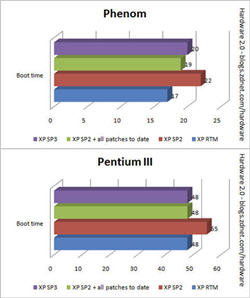XP SP3 performance gains - Nothing to write home about

Those who believed that Windows XP Service Pack 3 would provide the aging OS with a performance boost may well be disappointed. My benchmark tests show that the application of XP SP3 makes negligible difference to system performance.
The Test Systems
For this round of benchmarking I turned to two vastly different systems. At high end of the spectrum AMD Phenom-based system:
- Phenom 9700 quad-core processor
- ATi Radeon 3850 graphics card with 256MB RAM
- ASUS M3A32-MVP Deluxe motherboard
- 2GB (2 x 1GB) Corsair Dominator CM2X1024-8500C5D RAM
- Western Digital Raptor 10,000RPM 150GB primary hard drive
- Western Digital Caviar 7,200RPM 500GB secondary hard drive
At the low-end of the spectrum, I have a system that dates back to the Flintstone era, otherwise known as mid-2001:
- Intel Pentium III 800MHz
- SIS 6326 AGP card with 8MB RAM
- Gigabyte GA-6VX7-4X motherboard
- 512MB of no-name RAM
- 60GB Western Digital 5,400RPM primary hard drive
- 60GB Western Digital 5,400RPM secondary hard drive
Up until a few weeks ago this system was in daily use (albeit with 1.25GB of RAM installed) and it has performed flawlessly over the years (the PSU, motherboard and CPU are all the original parts, while the RAM and hard drives are newer).
The Tests -->
The Tests
Seven benchmark tests were carried out:
- Boot time Start the clock the moment POST hands over to the OS and stop the clock at a usable Start Menu.
- File copy - 1 Copy 1,676 files, 2.3GB from one drive to another.
- File copy - 2 Copy a single 2.5GB file from one drive to another.
- Compress Using Windows Compress tool, compress 1,676 files (2.3GB) of files.
- Extract Using Windows Compress tool, extract 1,676 files (2.3GB) of files.
- PassMark PerformanceTest Run PassMark PerformanceTest 6.1 to get a system score.
- PassMark PerformanceTest under load Run PassMark PerformanceTest 6.1 while the system is copying files from one drive to another (simulating load) to get a system score.
The OS
Both systems were wiped and then XP RTM was installed, along with a minimum set of additional drivers to get the system working (these drivers would be the latest available, which could skew the results a little). No optimizations were carried out other than to reboot the system several times, allowing the system to stand for 30 minutes at the desktop, process idle tasks and defrag the hard drive between each test.
After running the tests five times, XP SP2 was then installed and the process repeated.
After collecting a second set of results, all XP updates up to present were installed and the process repeated.
Finally, SP3 was installed and the final set of benchmarks run.
The Results -->
The Results
After all the tests were run the results were collected and the averages taken for each test. The results are presented below:
Boot time:
Time measured in seconds, lower is better.
File copy - 1:
Time measured in seconds, lower is better.
File copy - 2:
Time measured in seconds, lower is better.
Compress:
Time measured in seconds, lower is better.
Extract:
Time measured in seconds, lower is better.
PassMark PerformanceTest - No load:
Note: 3D graphics tests not carried out on the Pentium III system.
PassMark score, higher is better.
PassMark PerformanceTest - Under load:
Note: 3D graphics tests not carried out on the Pentium II system.
PassMark score, higher is better.
Conclusions -->
Conclusions
I could try to bring significance to the small variations in some of the times and scores that we've seen above, but to be honest there's only one real conclusion to come to - performance variations seen after applying service packs is small. Sometimes there are small gains (notice how compressing files becomes faster with each application) while other times there are performance losses (check out file copy - 2 on the Phenom system). Overall, the losses and gains seen are not significant.
SP3 isn't going to be a magic turbo boost button for XP systems. When SP3 was in beta (and the releasing of benchmark numbers without written permission was prohibited by Microsoft) many made bold claims that SP3 would bring with it huge performance gains. I never saw this in in-house testing that I carried out and the figures above for RTM SP3 reflect what I saw during the beta and release candidate phases of SP3 development.
So, why might some people be seeing their systems speed up after installing SP3? Well, I can think of two reasons:
- The first is that applying a service pack does refresh the OS installation. If a system is clogged up with detritus then a service pack can help tidy things up a little. Think of it as a mini-reinstall.
- The second reason is that people take the opportunity to refresh drivers, something that can have a significant effect.
What's true for XP SP3 is also true for Vista SP1. While Vista SP1 did fix certain performance issues, taking the system as a whole you don't really see these gains unless you are looking for them.
Thoughts?
<< Home >>
